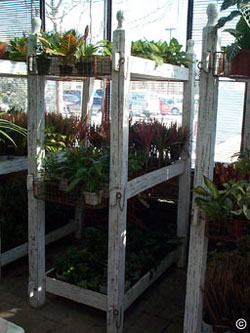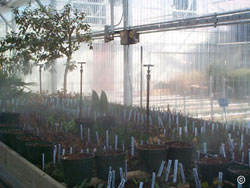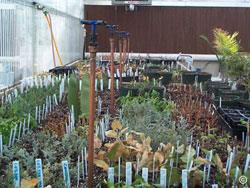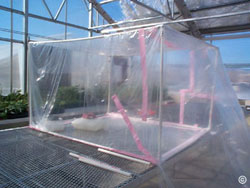
Greenhouse benches may be made of cypress, concrete, wire or fiberglass. The material you decide to use will depend on your budget, types of plants you grow, aesthetics and durability. Generally, benches are positioned in a permanent location in a hobby greenhouse, but larger, movable benches are also available.
A bench constructed approximately 30 inches high and no more than three feet wide allows easy access from one side. Legs and a box frame made of two-by-fours with wire pulled over the frame and stapled into place is adequate for many hobbyists. This type of bench is best suited for potted plants.

You might want to build a bench that not only holds potting soil, but allows you to plant directly in the soil. These benches weigh considerably more and require more support.
Benches may also be tiered, but be sure to allow adequate growing space between the tiers. These benches may present a problem when excess moisture from the upper shelf collects on plants on the lower shelf. They may also require additional lighting.

The intensity of sun in the High Plains and Rocky Mountain West means you’ll need to provide plants with shade. Fortunately, there are several inexpensive ways to cover greenhouse glass and protect plants from Colorado’s intense summer sun. One way is to mix whitewash or hydrated lime with water, then apply the mixture with a paint roller or sprayer over glass surfaces. However, lime solutions are not recommended for aluminum-framed greenhouses. Another inexpensive solution uses one gallon of white latex paint and eight gallons of water. Simply apply the mixture with a paint roller in late spring and it will wash off by the following fall. Commercial shade cloths made of aluminum, vinyl, plastic and other materials are also available.
Other supplies you will need in the greenhouse include a potting bench, substrate storage bins, a seed-storage area, a sink for cleaning, artificial lighting, and hoses and nozzles for watering and cleaning out containers.
You can start with a minimum of equipment and add items each year. A good minimum-maximum thermometer is essential because it will allow you to monitor temperatures in your greenhouse.
Record keeping is also important, because it will allow you to look back and learn from the problems and successes you experienced in previous growing seasons.



